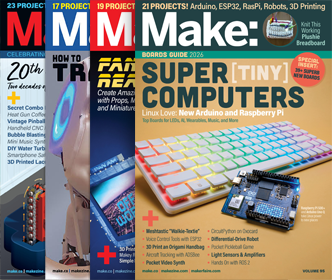Using an Oscilloscope
 Ever wonder what an Oscilloscope is? Or how to use one? Here’s a good guide on getting starting “An oscilloscope is easily the most useful instrument available for testing circuits because it allows you to see the signals at different points in the circuit. The best way of investigating an electronic system is to monitor signals at the input and output of each system block, checking that each block is operating as expected and is correctly linked to the next. With a little practice, you will be able to find and correct faults quickly and accurately.” Link.
Ever wonder what an Oscilloscope is? Or how to use one? Here’s a good guide on getting starting “An oscilloscope is easily the most useful instrument available for testing circuits because it allows you to see the signals at different points in the circuit. The best way of investigating an electronic system is to monitor signals at the input and output of each system block, checking that each block is operating as expected and is correctly linked to the next. With a little practice, you will be able to find and correct faults quickly and accurately.” Link.




 Great Instructable on making your own book wall hanging. I saw this in person a couple weeks ago, and I’m making a few as gifts for the holidays! – “Take one of the many beautiful books available at project Gutenberg and convert it into a wall sized readable book. Makes great gifts for the literary types in your life. This is the complete text of Flatlands, and how to generate and print it, at 60 x 42 inches. That’s huge! Take a look at the PDF.”
Great Instructable on making your own book wall hanging. I saw this in person a couple weeks ago, and I’m making a few as gifts for the holidays! – “Take one of the many beautiful books available at project Gutenberg and convert it into a wall sized readable book. Makes great gifts for the literary types in your life. This is the complete text of Flatlands, and how to generate and print it, at 60 x 42 inches. That’s huge! Take a look at the PDF.” 
 Interesting page documenting a homemade air rifle (also check out the
Interesting page documenting a homemade air rifle (also check out the 
 Chris writes “Remote controls are a consumption product. They fall in the floor, the get coffee spilled over them, the get stepped on (maybe not..) – and they wear out. In this how-to we will show you how to revive your remote by swapping the buttons around. Easier then you think actually.”
Chris writes “Remote controls are a consumption product. They fall in the floor, the get coffee spilled over them, the get stepped on (maybe not..) – and they wear out. In this how-to we will show you how to revive your remote by swapping the buttons around. Easier then you think actually.” 
 “Getting music to your Symbian phone is not as easy as it should be… If you are using a Nokia phone you may be able to use the Nokia Music Manager (which is part of PC Suite). This How-To shows you how Mass Storage Synchronizer can be used to copy music from iTunes to a memory card (which you can then put in your phone). This does not syncronize iTunes with the phone, it copies music from the PC (iTunes library) to a memory card in a USB memory card reader. ” Thanks Ewan!
“Getting music to your Symbian phone is not as easy as it should be… If you are using a Nokia phone you may be able to use the Nokia Music Manager (which is part of PC Suite). This How-To shows you how Mass Storage Synchronizer can be used to copy music from iTunes to a memory card (which you can then put in your phone). This does not syncronize iTunes with the phone, it copies music from the PC (iTunes library) to a memory card in a USB memory card reader. ” Thanks Ewan! 
 The C-3PO from
The C-3PO from 
 It wouldn’t be too hard to make your own pong clock (software app / Macromedia Flash) and put that on a LCD picture frame… “The dutch design company Buro Vormkrijgers has designed a clock which uses the popular videogame Pong to show the time. A random game of Pong is played, and when it’s time to change minutes or hours, one of the two sides will score, thus changing the score and the time. This has got to be one of the most inventive ways of using Pong ever!” There is video in download archives, showing how the clock works in real time. [
It wouldn’t be too hard to make your own pong clock (software app / Macromedia Flash) and put that on a LCD picture frame… “The dutch design company Buro Vormkrijgers has designed a clock which uses the popular videogame Pong to show the time. A random game of Pong is played, and when it’s time to change minutes or hours, one of the two sides will score, thus changing the score and the time. This has got to be one of the most inventive ways of using Pong ever!” There is video in download archives, showing how the clock works in real time. [